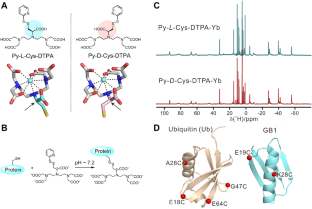Distinct stereospecific effect of chiral tether between a tag and protein on the rigidity of paramagnetic tag
Abstract
Flexibility between the paramagnetic tag and its protein conjugates is a common yet unresolved issue in the applications of paramagnetic NMR spectroscopy in biological systems. The flexibility greatly attenuates the magnetic anisotropy and compromises paramagnetic effects especially for pseudocontact shift and residual dipolar couplings. Great efforts have been made to improve the rigidity of paramagnetic tag in the protein conjugates, however, the effect of local environment vicinal to the protein ligation site on the paramagnetic effects remains poorly understood. In the present work, the stereospecific effect of chiral tether between the protein and a tag on the paramagnetic effects produced by the tag attached via a D- and L-type linker between the protein and paramagnetic metal chelating moiety was assessed. The remarkable chiral effect of the D- and L-type tether between the tag and the protein on the rigidity of paramagnetic tag is disclosed in a number of protein-tag-Ln complexes. The chiral tether formed between the D-type tag and L-type protein surface minimizes the effect of the local environment surrounding the ligation site on the averaging of paramagnetic tag, which is helpful to preserve the rigidity of a paramagnetic tag in the protein conjugates.


 求助内容:
求助内容: 应助结果提醒方式:
应助结果提醒方式:


